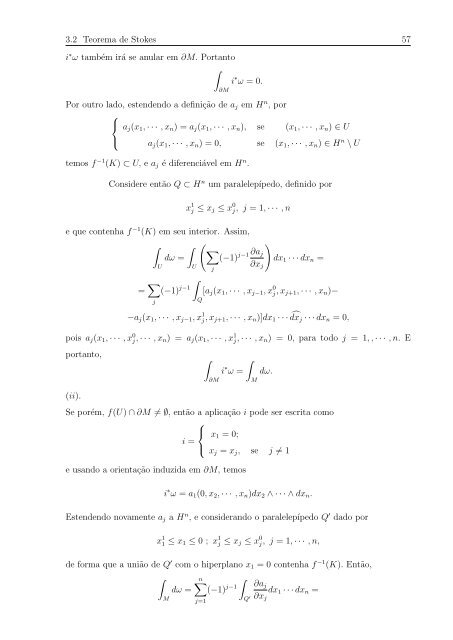O Teorema de Stokes em Variedades - Fernando UFMS/CPAq
O Teorema de Stokes em Variedades - Fernando UFMS/CPAq
O Teorema de Stokes em Variedades - Fernando UFMS/CPAq
Create successful ePaper yourself
Turn your PDF publications into a flip-book with our unique Google optimized e-Paper software.
3.2 <strong>Teor<strong>em</strong>a</strong> <strong>de</strong> <strong>Stokes</strong> 57<br />
i∗ω também irá se anular <strong>em</strong> ∂M. Portanto<br />
<br />
i ∗ ω = 0.<br />
Por outro lado, esten<strong>de</strong>ndo a <strong>de</strong>finição <strong>de</strong> aj <strong>em</strong> Hn , por<br />
⎧<br />
⎨ aj(x1, · · · , xn) = aj(x1, · · · , xn), se (x1, · · · , xn) ∈ U<br />
⎩<br />
∂M<br />
aj(x1, · · · , xn) = 0, se (x1, · · · , xn) ∈ H n \ U<br />
t<strong>em</strong>os f −1 (K) ⊂ U, e aj é diferenciável <strong>em</strong> H n .<br />
Consi<strong>de</strong>re então Q ⊂ H n um paralelepípedo, <strong>de</strong>finido por<br />
x 1 j ≤ xj ≤ x 0 j, j = 1, · · · , n<br />
e que contenha f −1 (K) <strong>em</strong> seu interior. Assim,<br />
<br />
dω =<br />
<br />
<br />
j−1 ∂aj<br />
(−1) dx1 · · · dxn =<br />
∂xj<br />
U<br />
U<br />
= <br />
(−1) j−1<br />
<br />
j<br />
Q<br />
j<br />
[aj(x1, · · · , xj−1, x 0 j, xj+1, · · · , xn)−<br />
−aj(x1, · · · , xj−1, x 1 j, xj+1, · · · , xn)]dx1 · · · dxj · · · dxn = 0,<br />
pois aj(x1, · · · , x 0 j, · · · , xn) = aj(x1, · · · , x 1 j, · · · , xn) = 0, para todo j = 1, , · · · , n. E<br />
portanto,<br />
(ii).<br />
<br />
∂M<br />
i ∗ <br />
ω =<br />
Se porém, f(U) ∩ ∂M = ∅, então a aplicação i po<strong>de</strong> ser escrita como<br />
⎧<br />
⎨ x1 = 0;<br />
i =<br />
⎩ xj = xj, se j = 1<br />
e usando a orientação induzida <strong>em</strong> ∂M, t<strong>em</strong>os<br />
M<br />
dω.<br />
i ∗ ω = a1(0, x2, · · · , xn)dx2 ∧ · · · ∧ dxn.<br />
Esten<strong>de</strong>ndo novamente aj a H n , e consi<strong>de</strong>rando o paralelepípedo Q ′ dado por<br />
x 1 1 ≤ x1 ≤ 0 ; x 1 j ≤ xj ≤ x 0 j, j = 1, · · · , n,<br />
<strong>de</strong> forma que a união <strong>de</strong> Q ′ com o hiperplano x1 = 0 contenha f −1 (K). Então,<br />
<br />
M<br />
dω =<br />
n<br />
(−1) j−1<br />
<br />
j=1<br />
Q ′<br />
∂aj<br />
dx1 · · · dxn =<br />
∂xj



